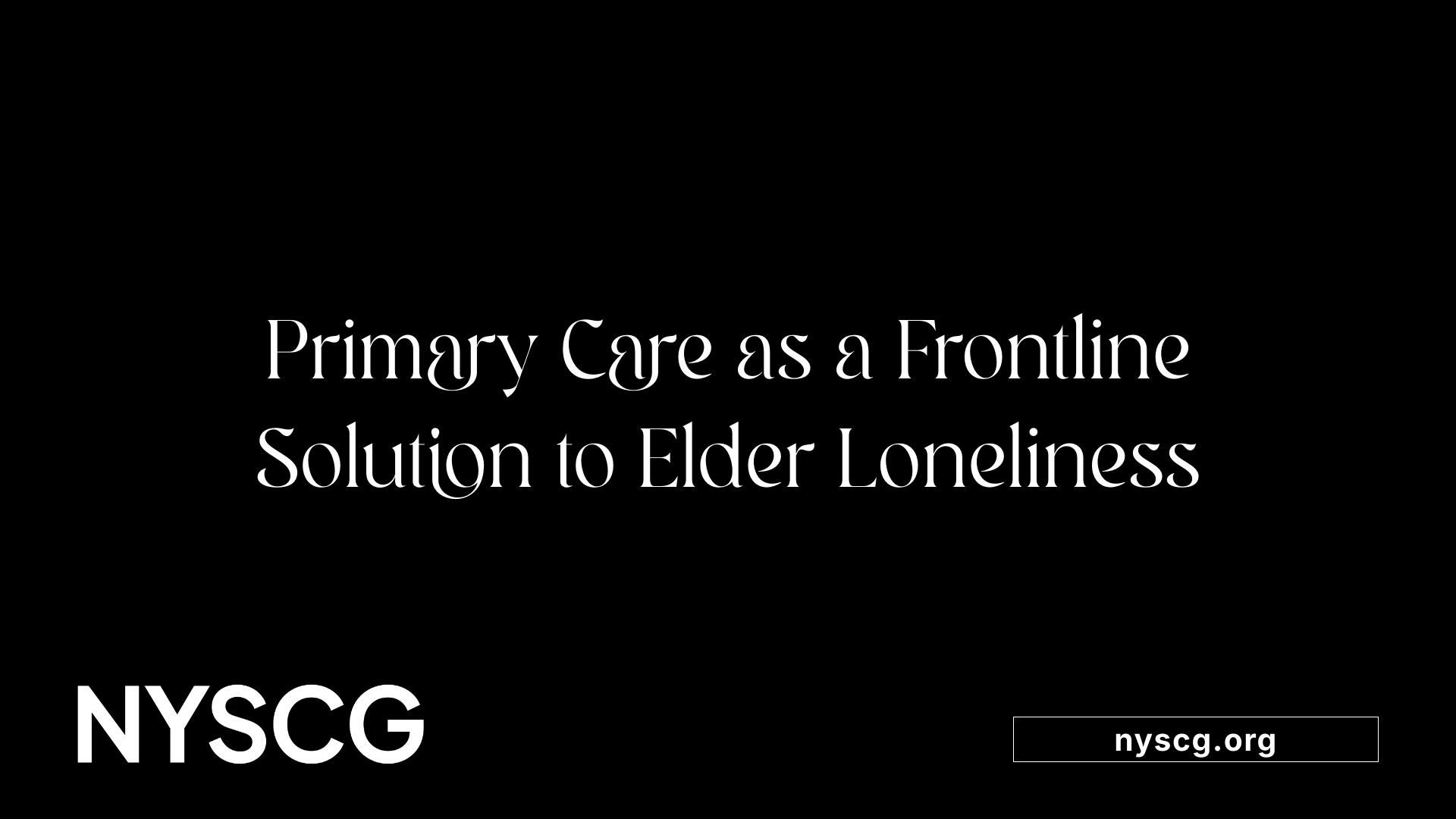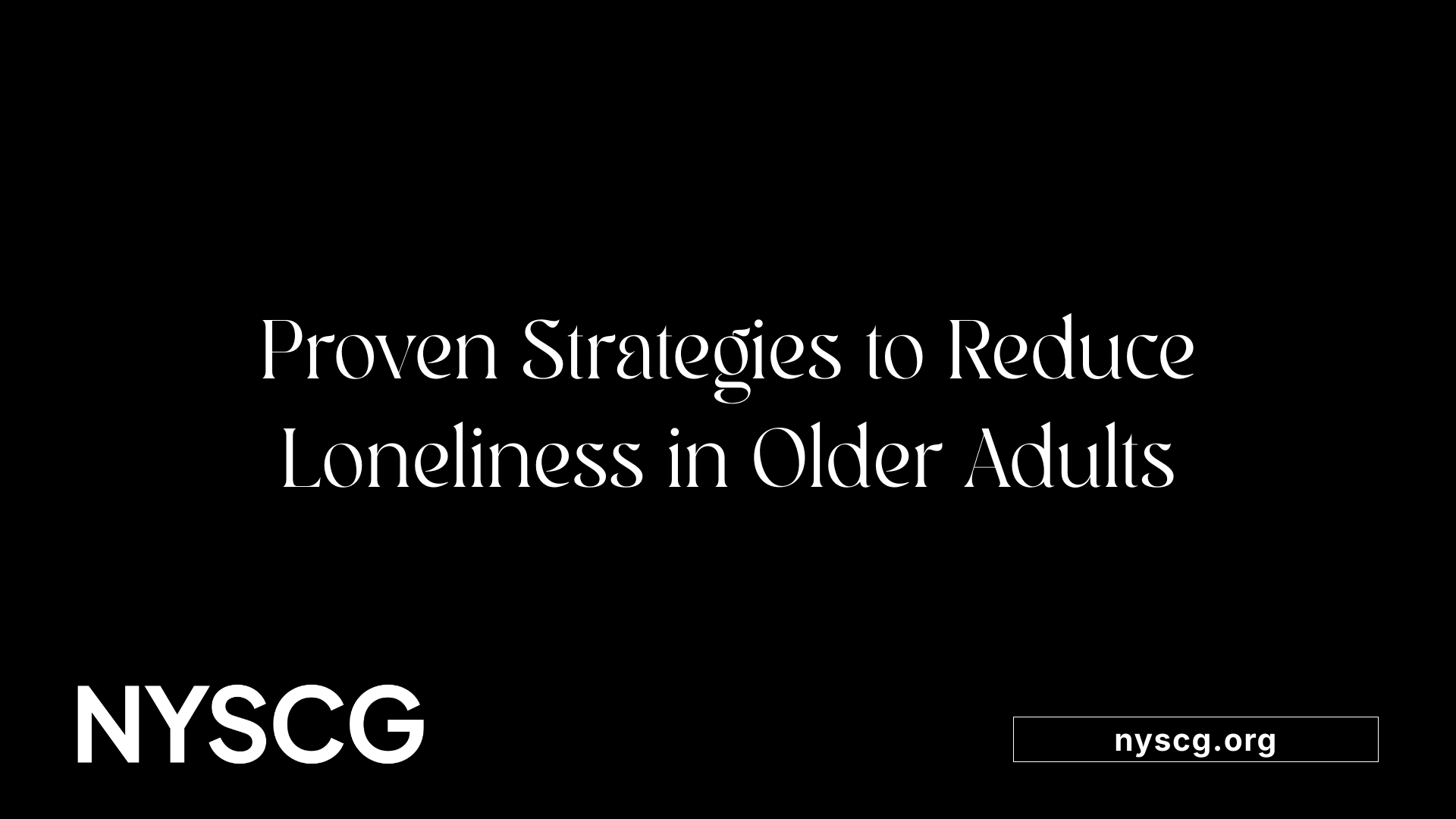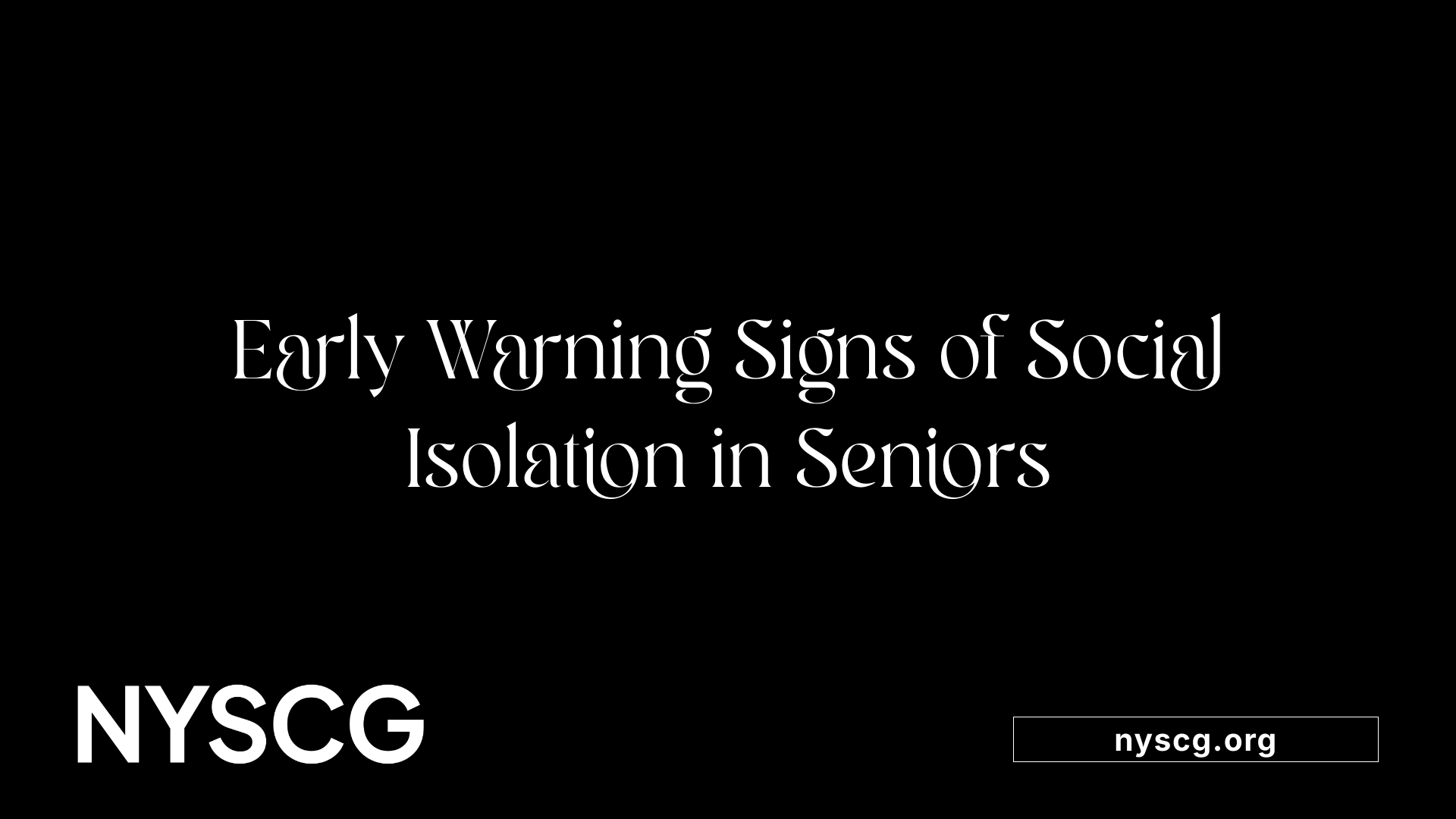Addressing Loneliness and Isolation in Elder Care


Loneliness and social isolation are pervasive challenges impacting the health and quality of life of older adults worldwide. These social determinants of health are associated with increased risks for mental health disorders, cardiovascular diseases, cognitive decline, and even premature death. Addressing these issues requires a multifaceted approach involving healthcare systems, community programs, policy frameworks, and technology innovations. This article explores the significance of social connection in elder care, examines effective interventions, and highlights strategies for integrating social health into comprehensive elder care models.

Maintaining social relationships is crucial for the health and happiness of older adults. Strong social ties have been shown to lower the risk of mental health issues such as depression and anxiety, as well as cognitive decline and diseases like dementia. Physically, being socially engaged helps reduce the chances of cardiovascular problems, diabetes, and other chronic illnesses.
Engaging with family, friends, and community not only promotes emotional well-being but also encourages healthier behaviors. Older adults who stay socially active tend to eat better, sleep more soundly, recover faster from health setbacks, and preserve their mental sharpness. In contrast, social isolation and loneliness are linked to increased health risks, including a 50% higher chance of premature death, a 30% greater risk of heart disease, and a doubled risk of developing dementia.
Creating opportunities for social interaction—such as community programs, intergenerational activities, and healthcare-based social interventions—is essential. These efforts help enhance quality of life, foster independence, and promote a healthier aging process, emphasizing that social connection is just as vital as medical care in supporting older adults' well-being.
The adverse effects of social isolation and loneliness extend deeply into both mental and physical health realms. Mentally, loneliness increases the risk for depression, anxiety, and cognitive disorders like Alzheimer’s disease. Physically, these social deficiencies are associated with higher incidences of stroke, heart disease, and even increased mortality rates.
Research indicates that loneliness can be as damaging to health as smoking 15 cigarettes daily or consuming six alcoholic drinks each day. It also leads to heightened stress responses, chronic inflammation, and a weakened immune system, making older adults more vulnerable to illnesses.
Social isolation contributes to increased healthcare utilization, more hospital admissions, and poorer adherence to treatment regimens. Combined, these effects significantly diminish quality of life and can shorten lifespan. Therefore, addressing loneliness and social isolation is critical for improving mental health outcomes and reducing physical health risks among the elderly.
The health impacts of social isolation and loneliness are rooted in biological responses that affect the body’s systems. Feeling lonely activates stress responses, releasing hormones like cortisol. Chronic activation of these stress pathways leads to sustained inflammation, which damages tissues and organs over time.
This persistent inflammation is linked to the development of cardiovascular diseases and accelerates cognitive decline, increasing the risk for dementia. Additionally, loneliness and social isolation can impair immune function, decreasing the body’s ability to fight infections.
Furthermore, social deprivation influences brain structures involved in emotional regulation and cognition, which can contribute to mental health issues and neurodegeneration. Addressing these biological mechanisms through social engagement and health interventions can help mitigate the harmful health effects associated with social isolation and loneliness in older adults.

Healthcare systems and primary care providers play a crucial role in addressing loneliness among older adults. One of the most effective strategies is implementing routine screening for social isolation and loneliness during medical visits.
Using validated tools such as the UCLA Loneliness Scale or the LSNS-6, clinicians can identify individuals at risk early on. Integrating this social determinants data into electronic health records helps in tracking and managing patients' social health alongside their physical health.
Connecting patients to community resources is essential. Primary care providers can refer older adults to local social activities, support groups, or community centers that foster social engagement. Addressing underlying health issues like mobility impairments, hearing or vision loss, and chronic illnesses can reduce barriers to social participation.
Psychological support, including cognitive behavioral therapy, can help those experiencing emotional distress linked to loneliness. Encouraging participation in meaningful activities such as volunteering, pet ownership, or online social platforms can enhance feelings of connection.
Building collaborations with community organizations and training healthcare staff on the importance of social health ensures a comprehensive approach. Such multi-sector efforts focus on creating supportive environments that promote social interaction, thereby improving overall health outcomes and quality of life for older adults.
Role of primary care in social connection and elder loneliness
By addressing social needs proactively, healthcare providers can significantly reduce the risks associated with loneliness, such as depression, cognitive decline, and physical health deterioration, ensuring healthier aging trajectories.

Combating social isolation and loneliness in older adults requires a multifaceted approach involving individual efforts, community initiatives, and policy actions. Evidence-based interventions include providing social skills training, establishing support groups, implementing befriending programs, and offering psychological therapies like cognitive-behavioral therapy. These strategies facilitate building meaningful social connections and help older adults develop coping mechanisms.
Creating environments that support social engagement is crucial. Developing age-friendly communities by improving public transportation, ensuring accessible communication technologies, and enhancing neighborhood safety promotes participation in social and recreational activities. For instance, community centers and senior clubs can serve as hubs for social interaction while also offering educational and recreational programs.
Public health campaigns play an important role in raising awareness about loneliness and its health impacts. Policies promoted by organizations such as the World Health Organization emphasize fostering supportive social environments. Innovative solutions like online therapy, telehealth services, and digital communication platforms have expanded access to social and mental health support, especially amidst challenges like the COVID-19 pandemic.
Community partnerships involving local governments, healthcare providers, and social organizations are instrumental in designing and implementing these interventions. When combined, these efforts can significantly reduce social isolation, improve mental and physical health, and enhance the overall well-being of older adults.

Addressing loneliness in older adults requires a comprehensive approach that promotes social engagement and leverages community resources. Engaging seniors in meaningful activities such as hobbies, volunteering, or participation in community programs at senior centers and libraries can foster connections and provide purpose.
Technology also plays a vital role. Using communication tools like video calls, social media, and online groups allows older adults to keep in touch with loved ones and peer networks, especially if they face mobility challenges or live alone.
Physical activity and pet companionship can significantly boost emotional health. Regular exercise not only improves physical health but also creates social opportunities, while trained therapy animals offer comfort and reduce feelings of loneliness.
Public health initiatives such as social prescribing—where healthcare providers connect patients to community resources—are gaining importance. Screening tools like the UCLA Loneliness Scale help identify at-risk individuals so interventions can be targeted effectively.
Fostering intergenerational programs and community involvement helps create a sense of belonging. Programs that promote friendship between different age groups and encourage community participation have been shown to lessen feelings of social isolation.
Combining these strategies—activities, technology, community engagement, and public health measures—can create a supportive environment, leading to improved mental and physical well-being among older adults.

Detecting loneliness or social isolation in seniors requires careful observation of behavioral, emotional, physical, and communication cues. Early signs include a noticeable withdrawal from previously enjoyed social activities, such as skipping family visits, community events, or religious gatherings. These individuals may start avoiding social interactions altogether, preferring to stay at home.
Emotionally, they might display increased sadness, irritability, or anger that appears disproportionate to their usual mood. Signs of depression or apathy may become evident, alongside feelings of vulnerability and mistrust towards others. Expressing feelings of being disconnected or having a lack of purpose is another common indicator.
Physical changes also serve as important clues. Changes in weight, poor personal hygiene, and declining mobility—such as difficulty walking or recent falls—can signal deteriorating well-being linked to social neglect. Sleep disturbances, like insomnia or hypersomnia, often accompany emotional distress.
In terms of communication, seniors experiencing loneliness may increase their internet or social media use as a substitute for face-to-face contact. Conversely, some may withdraw from all forms of communication, avoiding phone calls or messages. A significant decrease in interaction with family or friends, coupled with noticeable adjustments in daily routines or living arrangements, can further point to social isolation.
Caregivers and family members should remain attentive to these signs, as early intervention can help prevent further health decline related to loneliness and social isolation.
Advances in technology have opened new avenues for combating social isolation among older adults. Digital tools such as video calling platforms, social media, and messaging apps allow seniors to maintain contact with family, friends, and community groups regardless of physical distance. These platforms facilitate real-time conversations, photo sharing, and virtual gatherings, fostering a sense of belonging.
Additionally, social robots and AI companions like ElliQ and robotic pets provide emotional support and companionship. For example, ElliQ has demonstrated a 95% reduction in loneliness among users by encouraging daily interactions, engaging seniors in meaningful activities, and prompting participation in social events.
Virtual reality (VR) technology offers immersive experiences that can simulate social environments, trips, or cultural activities that seniors might otherwise be unable to access. These experiences can enhance mental and emotional well-being by providing engaging entertainment and social interaction.
Similarly, online social networks tailored for older adults, including community forums and interest groups, enable shared hobbies and peer support. Programs like GetSetUp offer free online classes and social engagements that encourage intergenerational and peer connections, combating loneliness through active participation.
While technology offers promising solutions, ethical considerations must be prioritized. Respecting seniors’ privacy and autonomy is essential, especially when deploying monitoring devices or AI systems. Transparent data handling policies, informed consent, and customizable privacy controls are necessary to ensure ethical use.
Moreover, balancing technological reliance with human interaction remains important. Digital tools should complement, not replace, genuine social relationships. Training caregivers and seniors in responsible tech use, along with establishing clear guidelines, can help mitigate potential risks of misuse or data breaches.
By integrating these innovations thoughtfully, communities and health services can better support older adults in maintaining social connections, ultimately improving their physical and mental health outcomes.
Addressing loneliness and social isolation is increasingly recognized as essential in elder care. Modern models emphasize a holistic approach that combines physical, mental, and social health components. Frameworks like the 4Ms—What Matters, Mentation, Medications, Mobility—are being integrated into healthcare systems, ensuring social connection is prioritized alongside medical treatment. Community-based programs, social prescribing, and in-home caregiving are crucial strategies in fostering meaningful social interactions.
Governments and organizations are developing policies that promote age-friendly environments. Initiatives include improving access to transportation, technology literacy, and community spaces that encourage social participation. Technological advances like AI-powered companions or virtual reality tools are being explored to supplement human contact, especially when mobility or health issues limit physical interactions.
Ongoing research highlights the importance of structured interventions, such as social skills training, support groups, and intergenerational activities. These evidence-based practices aim to increase social contact, improve perceptions of social interactions, and address biographical changes affecting social ties. Large-scale efforts like the WHO's Commission on Social Connection and national programs are fostering data collection, evaluation, and dissemination of best practices.
Adopting an integrated approach that combines these models, policies, and research insights is essential for building sustainable elder care systems that significantly reduce loneliness and enhance quality of life for aging populations.
Addressing loneliness and social isolation in elder care is a complex but vital endeavor that requires collaborative efforts across healthcare, community organizations, policymakers, and technology sectors. Implementing comprehensive, evidence-based interventions and fostering inclusive, age-friendly environments can significantly enhance social well-being, mental health, and overall quality of life for older adults. As the global population ages, prioritizing social connection in elder care will be essential for promoting healthy aging and reducing health disparities.
All you need is the will to make the world a better place.
New York State chaplain group inc. is a tax deductible organization with a federal tax Id number 92-383-4921